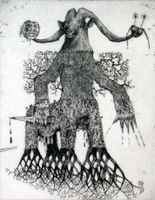
Enrique Chagoya, Liberty, 2006 - Jacquard Tapestry, 72 x 74 in. Edition of 8
Enrique Chagoya playfully examines contemporary
cultural and internal borders in his first tapestry,
Liberty. The work is a unique original, translated from
a composite of collaged, painted, and drawn elements
assembled digitally by Chagoya and Magnolia Editions
co-director Donald Farnsworth. Chagoya’s trademark
wit and spontaneity are reflected in the result, which
projects both a formal strength and a light-hearted energy.
Liberty depicts a plush domestic interior, reduced to a
flat anonymity using stark red lines; its placid blankness
is interrupted by the presence of dinosaurs,
originally rendered in bold strokes of charcoal. In the
foreground, a tiny, “realistically” colored dinosaur
bearing the head of Jesus is menaced by an enormous
Tyrannosaur while resting upon the stenciled word
“LIBERTY.” Besides the impersonal and military
connotations of the stencil, its letters are reversed,
suggesting an inversion of the word’s meaning and
perhaps implying that it is being stenciled onto the
viewer. As Chagoya’s ghostly, carbon-black dinosaurs
chase the hybrid Jesus figure almost off the edge of
the tapestry, they touch upon both the looming spectre
of America’s dependence on fossil fuels and the
ideological masks donned by warring powers to justify
their violent actions.
About the Magnolia Tapestry Project
The Magnolia Tapestry Project emerged from artist
John Nava’s commission to decorate the vast interior
walls of the Cathedral of Our Lady of the Angels
in Los Angeles, which required a consideration of
the acoustical demands of the space: the decorative
element was to function practically by reducing
unwanted reverberation, prompting an inquiry into
the use of textiles. Nava and Farnsworth subsequently
collaborated on a series of woven experiments which
grew into an unorthodox approach to Jacquard
weaving. Using this approach, work by contemporary
artists is faithfully translated into a digital “weave
file” using custom calibrated color palettes developed
at Magnolia Editions. The completed weave file is
woven in Belgium on a double-headed Jacquard loom,
where 17,800 available warp threads generate colors
of unprecedented variety and density. As the tapestry
translation process evolves, various textural elements
can be reproduced with clarity – in this light, Liberty is
particularly notable for the legibility of even the most
subtle of Chagoya’s charcoal marks, which appear as if
applied directly to the woven surface.
© 2006 Magnolia Editions, Inc. All rights reserved. Text by Nick Stone.
In the same way that Tamarind and Gemini put the
commercial lithographic technology of the 19th century
into the hands of fine artists in the fifties and
sixties, the Magnolia Tapestry Project is putting the
electronic Jacquard loom to work in unexpected ways
for today’s artists. The Project includes tapestries
representative of several generations and numerous
art movements: the Pop princesses of Mel Ramos; the
monumental, Expressionistic figures of Leon Golub;
the hyper-realism of Alan Magee and Guy Diehl; the
playful poetics of Squeak Carnwath and William Wiley;
the post-Surrealist visions of Bruce Conner, and the
abstractions of Ed Moses and George Miyasaki are all
re-envisioned in striking new editions. The Magnolia
Tapestry Project has also produced tapestries by
Chuck Close, Lia Cook, Lewis deSoto, Donald and Era
Farnsworth, Rupert Garcia, Diane Andrews Hall, Gus
Heinze, Robert Kushner, John Nava, Nancy Spero,
Katherine Westerhout and others.





























